Army Medical Department (United States)
The Army Medical Department of the U.S. Army (AMEDD), formerly known as the Army Medical Service (AMS), encompasses the Army's six medical Special Branches (or "Corps"). It was established as the "Army Hospital" in July of 1775 to coordinate the medical care required by the Continental Army during the Revolutionary War. The AMEDD is led by the Surgeon General of the U.S. Army, a lieutenant general.
| Army Medical Department | |
|---|---|
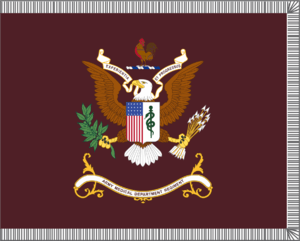 U.S. Army Medical Department Regimental flag | |
| Active | 1775 – present day |
| Country | |
| Branch | |
| Motto(s) | "Experientia et Progressus" |
The AMEDD is the U.S. Army's healthcare organization (as opposed to an Army Command), and is present in the Active Army, the U.S. Army Reserve, and the Army National Guard components. It is headquartered at Fort Sam Houston, San Antonio, Texas, which hosts the AMEDD Center and School (AMEDDC&S). Large numbers of AMEDD senior leaders can also be found in the Washington D.C. area, divided between the Pentagon and the Walter Reed National Military Medical Center (WRNMMC).
The Academy of Health Sciences, within the AMEDDC&S, provides training to the officers and enlisted service members of the AMEDD. As a result of BRAC 2005, enlisted medical training was transferred to the new Medical Education and Training Campus, consolidating the majority of military-enlisted medical training in Fort Sam Houston.[1][2]
The current Surgeon General of the U.S. Army and commander of the U.S. Army Medical Command (MEDCOM) is LTG R. Scott Dingle.
History
Both the AMEDD and the Army Medical Corps trace their origins back to July 27, 1775, when the Continental Congress established the "Army Hospital", which was at that time overseen by the "Director General and Chief Physician." Congress provided an Army medical organization only in times of war or emergency until 1818, at which point it created a permanent "Medical Department." The Army Nurse Corps originated in 1901, the Dental Corps began in 1911, the Veterinary Corps in 1916, the Medical Service Corps emerged in 1917, and the Army Medical Specialist Corps came into existence in 1947.[3]
The Army Organization Act of 1950 renamed the Medical Department to "Army Medical Service" and on June 4, 1968. The Army Medical Service was renamed the Army Medical Department.
Heraldry
Coat of arms
A regimental coat of arms was devised for the Medical Department and was most likely first used in 1818. The twenty white stars on a blue background and the red and white stripes represent the U.S. flag of 1818. The green staff entwined with a green serpent combined two symbols: the rod of Asclepius from classical mythology symbolizing medicine and healing, along with the color green associated with the Medical Corps during the last half of the 19th Century. The colors Argent (silver/white) and Gules (red) are associated with the flag of the United States. The rooster is associated with the ancient Greek and Roman god of healing and medicine, Aesculapius. The ancient Greeks believed that the rooster's crowing at dawn drove away the evil disease-spreading demons from the temples so that it could be a place of healing. The torse (twisted rope) below the rooster shows alternating blue and silver colors which were representative of the Army in 1818. The Latin motto Experientia et Progressus (Experience and Progress) is meant to convey the steady and unfailing progress of the Army Medical Department since 1775.
Regimental insignia (crest)

The design of the AMEDD regimental insignia (crest) is derived from the regimental coat of arms. It is one of the US Army's fourteen regimental corps insignias. The insignias are worn over the right breast pocket on the Army Service Uniform (ASU) and signify a service member's branch of service. The "new" AMEDD insignia was approved on October 27, 2014.
Branch (corps) insignia
- See also: Rod of Asclepius and Caduceus as a symbol of medicine
In 1851, "a caduceus embroidered in yellow silk on a half chevron of emerald green silk" was first authorized and worn by hospital stewards of the Medical Department. The caduceus in its present form was approved in 1902. Today, the AMEDD branch corps insignia is a gold color medal caduceus, 1 inch in height. With the exception of the Medical Corps, each Corps is identified by a black enamel letter (or letters) centered on the caduceus indicative of the specific branch. The insignia for Medical Service Corps is silver. Rooted in classical mythology and associated with the Greek god Hermes, the US Army's long-standing use of the caduceus has made it a well-known emblem of physicians and medical staff throughout the world. (Purists often assert that the rod of Asclepius, with its single serpent, is the more proper medical emblem.)
Medical special branches
There are currently six special officer branches (corps) in the AMEDD.
Medical Corps (MC)
The Medical Corps consists of commissioned medical officers who are physicians (Doctors of Medicine and Doctors of Osteopathic Medicine) who have completed at least one year of post-graduate training (internship) or have been promoted from O-1 to O-3 following completion of medical school through USUHS or the HPSP.
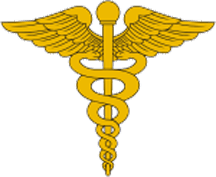
The MC traces its origins to 27 July 1775, when the Continental Congress created "a Hospital", essentially a Medical Department and corps of physicians, for the Continental Army. Medical officers in the United States Army were authorized uniforms only in 1816 and were accorded military rank only in 1847. Congress made the designation of "Medical Corps" official in 1908, although the term had long been in use informally among the AMEDD's regular physicians. Today, members of the MC work around the world at all echelons of the Army. The Chief of the MC is a major general, whereas the senior Army Medical Department officer is the Surgeon General (a lieutenant general).
Military physicians serve in one of several general career fields. The three main fields are operational field, clinical field, and research field.
Operational Medicine is the field of Army medicine that provides medical support to the soldier and his/her Chain of Command. Many operational physicians serve as Division, Brigade and Battalion level surgeons (the word "surgeon" is used to identify a physician that is assigned to a unit as a primary care provider and not necessarily as a General Surgeon). These physicians are either assigned through the "PROFIS" system or through permanent assignment (PCS). Deployments with units to combat theaters are for the duration of a deployment and the jobs are mostly filled by primary care physicians. A PROFIS provider can expect to be deployed away from their family for a total of 16 months (1 month before deployment, 12 months in theater, and 3 months for "stabilization" after return to the assigned units home station). This means that primary care physicians are deployed for longer periods than most "specialist physicians". A specialist (i.e. General Surgeon, Pulmonologist, Cardiologist, Trauma Surgeon, Rheumatologist) are usually deployed for 6 months. Operational Physicians should expect that more than 60% of their time will be spent in administrative roles and non-patient care. 40% of the operational providers time is spent caring for soldiers or supervising unit Physician Assistants (PA). With the recent Brigade Combat Team (BCT) restructuring, the demand for operational surgeons have increased. It is possible that the low retention rates of Captains and junior Major rank Physicians in the primary care fields are due to the discrepancies in deployment length and deployment frequency between primary care and specialty physicians.
Clinical Medicine is the field of Army medicine in which a physician in uniform performs similar functions to a physician in the civilian arena. These physicians are assigned to a PROFIS unit in one of the various Army MEDCEN (Medical Centers) and MEDDAC (Medical and Dental facilities). Primary care physicians usually deploy to fill battalion level surgeon positions. Medical specialists deploy to support CSH (combat support hospitals)
Research Medicine is filled by a minority of military physicians. Most of these research physicians are based in larger Army Medical Centers[4] and the research institutes.
Nurse Corps (AN)
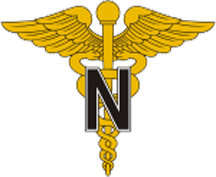
The Army Nurse Corps became a permanent corps of the Medical Department under the Army Reorganization Act (31 Stat. 753) passed by Congress on 2 February 1901.[5] Its motto is "EMBRACE THE PAST – ENGAGE THE PRESENT – ENVISION THE FUTURE" and its mission statement declares "All actions and tasks must lead and work toward promoting the wellness of Warriors and their families, supporting the delivery of Warrior and family healthcare, and all those entrusted to our care and ultimately, positioning the Army Nurse Corps as a force multiplier for the future of military medicine."
Dental Corps (DC)

The Dental Corps (DC) consists of commissioned officers holding the Doctor of Dental Surgery (DDS) degree or Doctor of Dental Medicine (DMD) degree. The chief of the Dental Corps is a major general. Enlisted soldiers may be assigned as dental assistants, although their collar insignia lacks the 'D' and is the same as that worn by medics. Army Dental Corps Officers may train further in the following advanced training programs after Dental School:
- Advanced Education in General Dentistry
- Comprehensive Dentistry (2-year AEGD)
- Endodontics
- Oral and Maxillofacial Surgery
- Orthodontics and Dentofacial Orthopedics
- Pediatric Dentistry
- Periodontics
- Prosthodontics
- Public Health Dentistry
- Oral Pathology
The US Army currently offers fellowship training in the following areas for Dental Corps Officers (applicants must have already completed a recognized specialty training program):
- Oral-facial pain
- Maxillofacial prosthodontics
- Healthcare Administration
- Dental informatics
The following ADA recognized specialties are not represented in the US Army Dental Corps:
- Oral and Maxillofacial Radiology
The chief of the Army Dental Corps is Major General Thomas R. "Rob" Tempel, Jr. His father, Major General Thomas R. Tempel, Sr. served as Chief of the Army Dental Corps from 1990–1994.[6]
Veterinary Corps (VC)
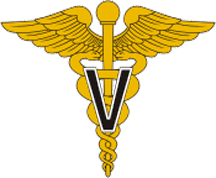
The U.S. Army Veterinary Corps was established by an Act of Congress on 3 June 1916. Recognition of the need for veterinary expertise had been evolving since 1776 when General Washington directed that a "regiment of horse with a farrier" be raised.[7]
The US Army Veterinary Corps plays a significant role in current operations. Veterinary units are critical in ensuring remarkably low food borne illness rates. This is in great measure a result of veterinary inspection of subsistence in the United States as well as the approval of safe food sources around the world. Army veterinarians ensure the health of military working dogs and assist with host-nation related animal emergencies. Veterinary staff advisors also play key roles regarding issues involving chemical and biological defense.[7]
In the United States, military veterinary supervision of operational ration assembly plants, supply and distribution points, ports of debarkation, and other types of subsistence operations are critical to ensuring safe, wholesome food for our Soldiers, Sailors, Airmen, Marines, and their family members. The large segment of the Veterinary Corps involved in Medical Research and Development missions contribute immeasurably to the overall military effort. Vaccine, antitoxin, and antidote development, directed toward the protection of military personnel, has been and will continue to be, heavily reliant on military veterinary expertise.[7]
Today, the Army Veterinary Corps, composed of approximately 800 veterinarians and warrant officers in both active and the Army Reserves, has an over 100 years of historic achievements about which it can be tremendously proud. Accomplishing its broad functions of food safety and security, animal health care, veterinary public health, and research and development, will continue to be essential as long as the need for military forces remain.[7]
The Chief of the Veterinary Corps is Colonel Steven Greiner.
Medical Service Corps (MS)

The Medical Service Corps consists of commissioned and warrant officers. Members are required to hold at least a bachelor's degree before receiving a commission. The MSC has the greatest range of duties performed by personnel. These may include administrative and support duties, such as healthcare administrators, health services officers in operational units, healthcare comptrollers, healthcare informatics officers, patient administrators, health service human resource managers, health physicists, toxicologists, sanitary engineers, medical operations and plans officers, medical logisticians, health services maintenance technicians, and medical evacuation pilots. MSC officers serve in clinical support roles as clinical laboratory science officers, environmental science officers, pharmacists and preventive medicine officers. Medical Service Corps officers serve as commanders of field medical units in garrison and combat environments, and provide healthcare to patients as psychologists (PhD, PsyD), social workers (MSW with state license), optometrists, pharmacist, podiatrists, and audiologists. The Medical Service Corps also functions as a transitional branch, encompassing commissioned medical, dental, and veterinary students who have not completed their training through the Uniformed Services University of the Health Sciences (USUHS) or the Health Professions Scholarship Program (HPSP).
Medical Service Corps officers are drawn from the various Army commissioning sources (USMA, ROTC, and the federal and state Officer Candidate Schools) following a branch-immaterial curriculum. Since a primary function of the Medical Service Corps is to manage combat health support activities,[8] its officers hold general command authority and can compete for company and field grade command of medical support formations and detachments, as well as logistics and aviation commands along with officers of the "Army competitive category" branches, such as infantry, ordnance, quartermaster. In contrast, Medical Corps, Veterinary Corps and Dental Corps officers are limited to command billets specific to their respective corps (e.g. AMEDD Immaterial commands for Medical, Nurse, and Medical Specialist Corps officers; branch specific commands for Medical, Dental, and Veterinary Corps officers).[9]
The 19th Chief of the Medical Service Corps is Major General Dennis P. LeMaster effective 18 June 2019.
Medical Specialist Corps (SP)

The Army Medical Specialist Corps consists of commissioned officers. Members hold professional degrees and serve as clinical dietitians, physical therapists, occupational therapists, and physician assistants. Members of the SP serve all around the world and at all echelons of the Army. The Chief of the SP Corps is COL John E. Balser.[10]
Aviation Section
On 20 December 1971 the Aviation Branch became part of the Force Structure Branch, Force Development Division.[11]
The section controlled a number of units including:
- 45th Medical Company (Helicopter Ambulance)[13]
- 92nd Medical Helicopter Company
- 171st Air Ambulance Company
- 498th Medical Company (Air Ambulance)[14]
- 8th Medical Detachment[15]
- 25th Medical Detachment[15]
- 41st Medical Detachment[15]
- 50th Medical Detachment (Helicopter Ambulance)[16]
- 54th Medical Detachment (Helicopter Ambulance)[16]
- 57th Medical Detachment (Helicopter Ambulance)[17]
- 82nd Medical Detachment (Helicopter Ambulance)[14]
- 83rd Medical Detachment[18]
- 94th Medical Detachment[18]
- 129th Medical Detachment[18]
- 130th Medical Detachment[18]
- 154th Medical Detachment[18]
- 159th Medical Detachment (Helicopter Ambulance)[16]
- 163rd Medical Detachment[18]
- 236th Medical Detachment[18]
- 237th Medical Detachment (Helicopter Ambulance)[19]
- 254th Medical Detachment (Helicopter Ambulance)[16]
- 283rd Medical Detachment (Helicopter Ambulance)[20]
- 286th Medical Detachment[21]
- 430th Medical Detachment[22]
- 431st Medical Detachment[22]
- 432nd Medical Detachment[22]
- 433rd Medical Detachment[22]
- 534th Medical Detachment[22]
- 546th Medical Detachment[22]
- 571st Medical Detachment (Helicopter Ambulance)[16]
- 755th Medical Detachment[22]
- 756th Medical Detachment[22]
- 758th Medical Detachment[22]
- 759th Medical Detachment[22]
- 772nd Medical Detachment[22]
- 774th Medical Detachment[22]
Enlisted Medical Career Management Fields (CMFs)
There are currently 24 Military Occupational Specialties (MOSs) for enlisted medical soldiers:
- 68A Biomedical Equipment Specialist
- 68B Orthopedic Specialist
- 68C Practical Nursing Specialist
- 68D Operating Room Specialist
- 68E Dental Specialist
- 68F Physical Therapy Specialist
- 68G Patient Administration Specialist
- 68H Optical Laboratory Specialist
- 68J Medical Logistics Specialist
- 68K Medical Laboratory Specialist
- 68L Occupational Therapy Specialist
- 68M Nutrition Care Specialist
- 68N Cardiovascular Specialist
- 68P Radiology Specialist
- 68Q Pharmacy Specialist
- 68R Veterinary Food Inspection Specialist
- 68S Preventive Medicine Specialist
- 68T Animal Care Specialist
- 68U Ear, Nose, and Throat (ENT) Specialist
- 68V Respiratory Specialist
- 68W Combat Medic Specialist
- 68X Behavioral Health Specialist
- 68Y Eye Specialist
- 68Z Chief Medical NCO
In addition, outside the AMEDD, is the Special Forces Medical Sergeant (18D).
Museum
Badges
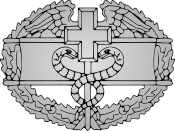

 Flight Surgeon Badges
Flight Surgeon Badges
See also
- United States Army Medical Department Museum
- United States Army Medical Command (MEDCOM)
- Order of Military Medical Merit (O2M3)
- Surgeon General of the United States Army (TSG)
- 68W (91W) (medic; U.S. Army)
- List of General Officers of the United States Army Medical Department in World War II
- List of ships of the United States Army#Hospital ships
- United States Army Ambulance Service (World War I)
- Battlefield medicine
- Combat Support Hospital (CSH)
- Field hospital
- Mobile Army Surgical Hospital (MASH)
- Military medicine
- U.S. Navy Dental Corps
- U.S. Air Force Dental Corps
- U.S. Navy Medical Corps
- U.S. Air Force Medical Corps
- U.S. Navy Medical Service Corps
- U.S. Air Force Biomedical Sciences Corps
- U.S. Air Force Medical Service Corps
- U.S. Navy Nurse Corps
- U.S. Air Force Nurse Corps
References
Citations
- "Fort Sam Houston" (PDF). United States Air Force. Archived from the original (PDF) on 23 January 2014. Retrieved 13 February 2011.
- "Fort Sam Houston". GlobalSecurity.org. 21 August 2005. Archived from the original on 13 March 2011. Retrieved 13 February 2011.
- AMEDD Corps History Archived 2 September 2011 at the Wayback Machine. Office of Medical History. U.S. Army Medical Department (AMEDD). Retrieved 2011-08-26.
- Army Medical Department (AMEDD), "Training, history, education, FAQ"; Available from www.amedd.army.mil/
- Carolyn M. Feller; Debora R. Cox, eds. (2000). Highlights in the history of the Army nurse corps. CMH Pub 85-1 (Revised and Expanded ed.). Washington, DC: United States Army Center of Military History. p. 103.
- Dr. Valencia L. Dunbar (5 June 2014). "The Tempel Legacy: Approaching a Century of Service to Army Medicine". The Official Homepage of the United States Army. United States Army. Archived from the original on 21 April 2016. Retrieved 3 June 2016.
- "U.S. Army Veterinary Corps History". US Army Medical Department. 2014. Archived from the original on 25 April 2017.

- "Medical Service Corps". medicalservicecorps.amedd.army.mil. Archived from the original on 22 August 2017. Retrieved 4 May 2018.
- AR 600-20, Army Command Policy
- "AMSC". amsc.amedd.army.mil.
- "Annual Report 1972". The Surgeon General United States Army. 20 February 2020. p. 124.
- "General Orders 1969 - No. 46" (PDF). U.S. Army. 20 November 2019. p. 3.
- Dunstan 1988, p. 140.
- Dunstan 1988, p. 137.
- "General Orders 1969 - No. 46" (PDF). U.S. Army. 20 November 2019. p. 3.
- Dunstan 1988, p. 139.
- Dunstan 1988, p. 132.
- "General Orders 1969 - No. 46" (PDF). U.S. Army. 20 November 2019. p. 4.
- Dunstan 1988, p. 147.
- Dunstan 1988, p. 136.
- "General Orders 1969 - No. 46" (PDF). U.S. Army. 20 November 2019. p. 5.
- "General Orders 1969 - No. 46" (PDF). U.S. Army. 20 November 2019. p. 6.
Further reading
- Ashburn, Percy M. (1929), A History of the Medical Department of the United States Army, Boston: Houghton Mifflin.
- Bayne-Jones, Stanhope (1968), The Evolution of Preventive Medicine in the United States Army, 1607–1939, Washington, D.C.: Office of the Surgeon General.
- Dunstan, S (1988). Vietnam Choppers. UK: Osprey Publishing Ltd. ISBN 0-85045-572-3.
- Gillett, Mary C. (1981), The Army Medical Department, 1775–1818, Washington, DC: United States Army Center of Military History, United States Army. (Series: Army Historical Series)
- Gillett, Mary C. (1987), The Army Medical Department, 1818–1865, Washington, DC: Center of Military History, United States Army. (Series: Army Historical Series)
- Gillett, Mary C. (1995), The Army Medical Department, 1865–1917, Washington, DC: Center of Military History, United States Army. (Series: Army Historical Series)
- Gillett, Mary C. (2009), The Army Medical Department, 1917–1941, Washington, DC: Center of Military History, United States Army. (Series: Army Historical Series)
- Hume, Edgar Erskine (1943), Victories of Army Medicine: Scientific Accomplishments of the Medical Department of the United States Army, Philadelphia: Lippincott.
- McPherson, Darrell G. The Role of the Army Medical Service in the Dominican Republic. Washington D.C.: Office of the Surgeon General, Department of the Army. – full text
- Tobey, James A. (1927), The Medical Department of the Army: Its History, Activities and Organization, Baltimore: Johns Hopkins Press; Reprint: New York: AMS Press, 1974.
- Vuic, Kara Dixon. Officer, Nurse, Woman: The Army Nurse Corps in the Vietnam War (Johns Hopkins University Press; 2010) 320 pages; Draws on more than 100 interviews
- Wintermute, Bobby A. Public Health and the U.S. Military: A History of the Army Medical Department, 1818–1917 (Routledge, 2011) 283 pp. ISBN 978-0-415-88170-8
- This article also contains information that originally came from US Government publications and websites and is in the public domain.
External links
- Office of Medical History
- U.S. Army Medical Department official webpage (on U.S. Army official website). Retrieved 2009-12-05.
- U.S. Army Medical Corps official webpage (on U.S. Army official website). Retrieved 2009-12-05.
- U.S. Army Nurse Corps official webpage (on U.S. Army official website). Retrieved 2009-12-05.
- Army Nurse Corps History
- Army Nurse Corps history and WWII women's uniforms in color (WAC, WAVES, ANC, NNC, USMCWR, PHS, SPARS, ARC and WASP)
- U.S. Army Veterinary Corps History
- WW2 U.S. Medical Research Centre
- US Army Nurse Corps Collection
- Digital Military Medicine Collections of the U.S. Army Academy of Health Sciences, Stimson Library
- LTG Schoomaker's blog
- That Men Might Live!: The Story of the Medical Service in WWII
- The short film Big Picture: The Army Medical Service Corps is available for free download at the Internet Archive
